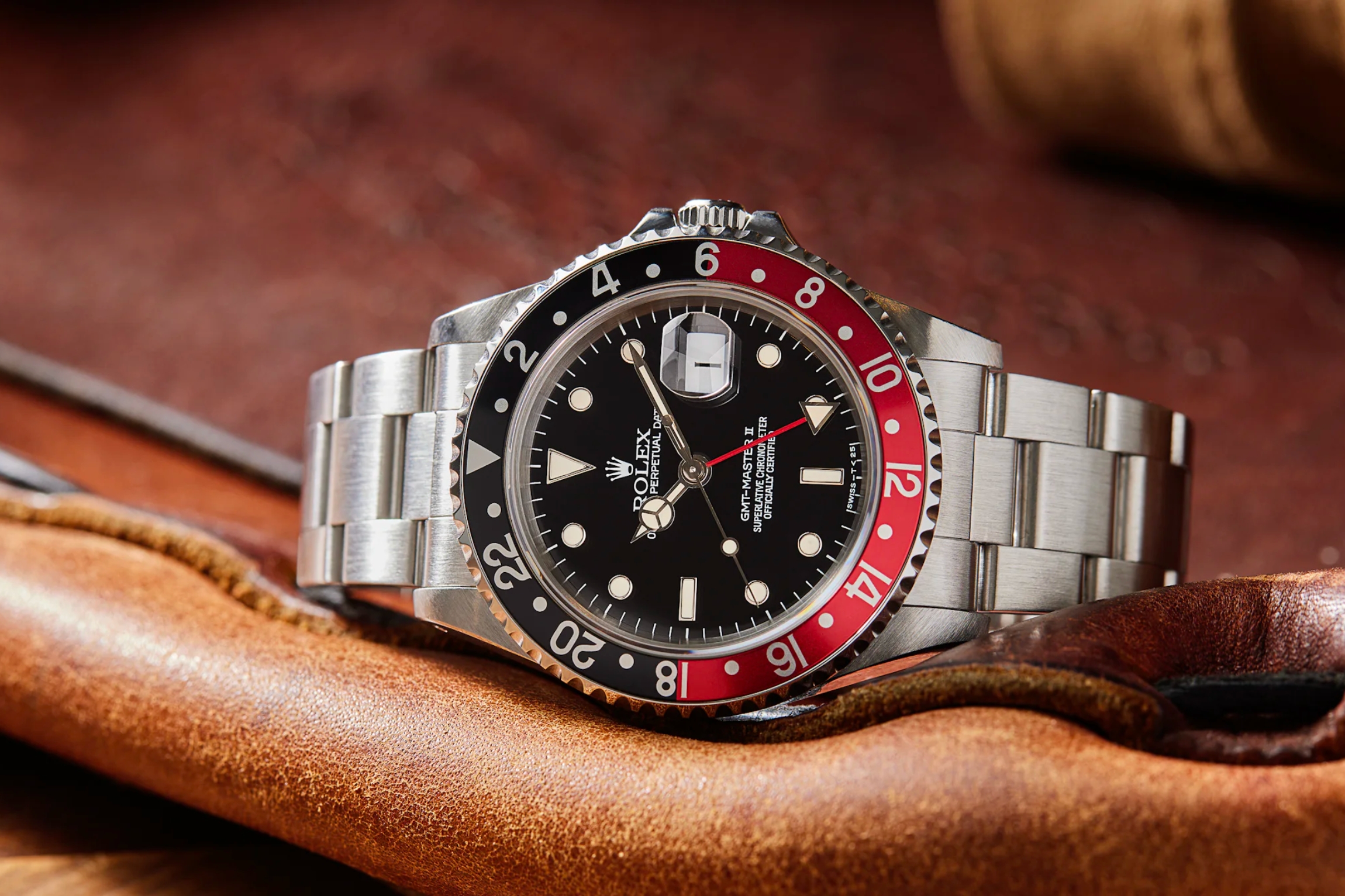
Wristcheck's Guide To The Rolex GMT-Master (Part 2)
We deep dive into the evolution of the Rolex GMT-Master, one of the most coveted travel watches from Rolex
In the early 1980s, Rolex began introducing the next generation of its sports watches, marking a significant evolution in its product line. Among these changes, the GMT-Master was updated and renamed the GMT-Master II with several new innovative and cutting-edge watchmaking updates including a sapphire crystal, a quick set date, a glossy dial with white gold surround hour markers, and notably, a new independently setting 24-hour hand. This feature was a major development for the GMT-Master line, enhancing its versatility and therefore its desirability.
The launch of the GMT-Master II in 1983 introduced several innovations that have remained key elements of the GMT series over the decades. The most critical was the independently adjustable 24-hour hand, allowing wearers to move the hand forwards or backwards independently of the main hour hand. This capability, combined with the rotating bezel, meant that the watch could effectively track time in three separate time zones simultaneously.
The Fat Lady Sings
The first GMT-Master II was reference 16760, equipped with the new caliber 3085. This model was the first in the GMT Master series to incorporate a sapphire crystal, unlike the transitional GMT Master (reference 16750) which still used an acrylic one. During this transitional time, sapphire crystals, known for their durability and enhanced waterproofing qualities, were also being used in the Explorer II. Interestingly, the Explorer (reference 1016) and the Submariner non-date (reference 5513) continued with acrylic crystals until the late 1980s.

The reference 16760 featured a notably thick case with robust crown guards, earning it the nickname ‘Fat Lady’. Collectors also affectionately referred to this model as ‘Sophia Loren’, inspired by its pronounced lines and curves, a testament to the enduring charm of Italian-themed nicknames in the world of vintage Rolex. During this period, Rolex also experimented with different bezel colour schemes. The introduction of the 'Coke' bezel — a black and red combination — added a new flavour to the existing 'Pepsi' (blue and red) and all-black options.
Slimmer Times
By 1989, Rolex further refined the GMT-Master II with the introduction of reference 16710, which featured the new caliber 3185 and sported a slimmer case, addressing feedback from users who found the previous 'Fat Lady' model too bulky. This reference enjoyed a long production run, remaining in the line-up for 18 years and witnessing the return of two-tone and gold versions in the GMT-Master series.

The 18k gold model, known as reference 16718, was offered with a choice of a black dial with an all-black bezel insert or a brown dial with a bronze-coloured bezel insert. Each variant displays a distinct personality and appears remarkably different when worn. Similarly, the two-tone version was available with either a black dial and black bezel insert, or a brown dial paired with a bronze and gold bezel insert — the classic ‘Root Beer’ GMT. The brown dial features a 'soleil' or sunburst finish, which adds a dynamic visual layer to the watch. When these dials catch the sunlight, the effect is truly spectacular!

The details in each model variation are crucial to collectors, including every letter and font size used on the dials, as these variations help chart the evolution of the series. Reference 16710, for example, used different codes to indicate the type of bezel insert initially fitted — 'Coke', 'Pepsi', and plain black. Changes in luminous materials on the dials and hands also marked different production periods, from tritium to Luminova and subsequently to Super Luminova, each identifiable by specific markings on the dial.
The Ceramic Era
The 2000s brought further innovation with the launch of the reference 116718 in 2005. This model featured an entirely new case design with heavier lugs and crown guards, a ceramic bezel insert which replaced the aluminium ones used previously and was available in luxurious 18k gold. The ceramic material, branded as Cerachrom, was praised for its resistance to scratches and UV light, addressing the fading issues seen in older models.

Rolex's development of the Cerachrom bezel was a significant achievement in materials engineering, initially available only in single colours due to the complexities of the manufacturing process. However, by 2012, Rolex had perfected a method to create a two-colour bezel, first showcased on the 117610 BLNR (bleu noir) with a black and blue 'Batman' bezel. This innovation was followed by the reintroduction of the iconic 'Pepsi' bezel in white gold in 2013 and eventually in stainless steel, much to the delight of enthusiasts and collectors.
The Latest Lines
The newest additions to the GMT family are powered by the latest in the 24-hour movement development, calibre 3285. The steel watches are now reference 126710, with the 2024 iteration having a grey and black bezel (as indicated by the reference GRNR (gris noir). At Watches and Wonders 2022, however, Rolex did something that nobody had expected and produced a left-handed or ‘destro’ version of its iconic travel watch. Reference 126720VTNR (vert noir) was a green and black bezel GMT watch with the winding crown on the left and side of the case. Known as the ‘Sprite’, the watch was initially quite divisive, but them isn’t that half the fun of new launches?!

The most recent iterations of the GMT-Master II continue to reflect the brand's commitment to innovation and reverence for its heritage; a point very much highlighted by the amazing GMT-Master exhibition at Watches and Wonders 2024. The combination of historical design elements with modern technology and materials demonstrates Rolex's ongoing pursuit of perfection and its dominant position in the luxury watch market. As we look to the future, the evolution of the GMT-Master line promises to continue blending tradition with cutting-edge advancements, ensuring its place as a timeless icon in the world of horology.



